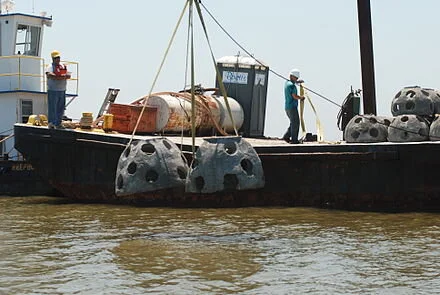Via ecoRI News (ecori.org)
JAMESTOWN, R.I.
There is nothing yet linking the Block Island Wind Farm to the death of humpback whales, but that hasn't stopped anti-wind and conservative groups from making the connection.
The recent stranding and death of a 32-foot juvenile humpback whale in Jamestown triggered speculation, and in some cases unsubstantiated assertions, that noise from the first U.S. offshore wind farm caused this and other whales to die. As the HuffPost recounts, the claim was first made by the conservative Web site Daily Caller and through a conservative news wire has been republished and rewritten in various forms by national new outlets such as The Blaze and through local anti-wind groups and press reports that inferred the link. The Newport Buzz names the five-turbine wind farm as the prime suspect.
None of the anti-wind articles offer a scientist as a source for their claims or research that deduces that the wind farm, owned by Providence-based Deepwater Wind, caused the whale to beach itself. Only the HuffPost quoted a marine biologist, at Cornell University, who said wind turbines contribute to the cacophony of underwater noise from boats, ships and barges, and that this mix of manmade noise — which can also include sonar, fossil-fuel drilling and military exercises and testing — can disorient but isn't likely to kill marine life.
Jeff Grybowski, CEO of Deepwater Wind, told ecoRI News that the five turbines are simply not to blame. "There is absolutely no evidence that the wind farm is in any way connected to this whale," he said. "The wind farm does not create any special risks to marine life. In fact, marine life is thriving near the project.”
As part of its approval process, the wind farm and its transmission system received a finding of no significant impact for acoustic impacts by the federal Bureau of Ocean Energy Management.
Deepwater Wind has a lot riding on the emerging offshore wind industry. The wind and solar developer has several wind farms in the works between New York and Massachusetts. The wind-rich region has also attracted developers from Norway, Denmark and other countries with established wind industries.
Here's what is known about the death of the Jamestown humpback whale:
A necropsy was performed by Mystic Aquarium at the site of the stranding at Beavertail State Park. Tests to determine the case of death were sent to a laboratory and aren't expected for weeks.
The Rhode Island Department of Environmental Management (DEM) won’t say where the carcass was buried. In 2005, a 50-foot finback whale found dead on Newport’s Brenton Point State Park was buried at the Great Swamp Management Area in West Kingston.
There has been a spike in humpback whale deaths along the East Coast between North Carolina and Maine. Since January, 48 humpbacks deaths have been reported. Although ship strikes and entanglements with fishing gear are the main killers of humpback whales, the recent increase in humpback deaths has been classified as an unusual mortality event by the National Oceanic and Atmospheric Administration (NOAA). An investigative team will review data, study samples from future strandings and decide what, if any, action to take.
NOAA also lists sonar, military testing, resort development and increased boat traffic as threats to humpback whales and their habitat.
The Jamestown whale death coincides with a surge in humpback whale sightings between mainland Rhode Island and Block Island, according to DEM. The whales are likely drawn to a growing food supply — the small, eel-like forage fish, called the American sand lance — DEM said.
Humpback whales are protected under the federal Endangered Species and Marine Mammal Protection acts. They grow to about 60 feet in length and have a lifespan of about 50 years. They are the most popular marine mammal for whale watching in New England, because of their habit of breaching and slapping the water surface with their tails.
Tim Faulkner writes frequently for ecoRI News. {Editor's note from Robert Whitcomb, co-author of Cape Wind: Whales and other marine mammals are primarily threatened by boats running into them, fishing nets, human overfishing of fish eaten by some marine mammals, fossil-fuel and other manmade pollution, and acidification and other seawater changes caused by a human-caused increase in greenhouse gases caused by burning fossil fuels. Offshore wind turbines are not implicated in whale deaths. Many conservative and anti-wind people have close economic ties to the oil, natural gas and coal industries.}
















